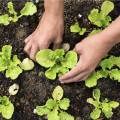Tips
Planting and Thinning Tips
Plant only fresh seeds from a reliable source. Old seeds are slow to germinate and often produce spotty stands and deformed plants.

When planting seeds, mark straight rows with stakes and a cord to make cultivating, spraying, and harvesting easy. Rake the seed bed clean of clods, rocks, and other types of debris. Make shallow furrows suitable for small seeds by drawing a hoe handle along a string.
For deeper furrows, use a corner of the hoe blade. In the spring, plant seeds shallow to speed germination. As the season progresses, plant seeds deeper to ensure a good supply of moisture.
Small seeds are difficult to distribute thinly and evenly and are easier to space if mixed with dry sand or dry, pulverized soil before planting. When planting small seeds like carrots that germinate slowly, mix in some radish seeds to mark the row.
Seeds that are large enough to handle easily can be planted in groups (hills) or spaced evenly (drilled) in the row. When planting in hills, place several seeds in small areas at the desired final plant spacing. Sweet corn, squash, pumpkins, melons, and okra are often planted in this way. Once the seeds germinate and the seedlings are established, remove the excess seedlings. Sweet corn, okra, and summer squash are thinned to one plant per hill, pumpkins and melons to two plants per hill.
Seeds of beans, peas, beets, chard, and sweet corn are frequently spaced evenly down the row when planted. Individual seeds may be spaced 1 or more inches apart but at a spacing closer than the desired final plant spacing.
After germination and seedling establishment, remove extra seedlings. The choice of planting method, drill or hill, for many vegetables is up to the gardener.
If your seeds are 1 or more years old, plant them thicker than you would fresh seeds. Extra seeds at planting time cause poor germination and seedling death from disease and insects.
After the seeds are placed, cover them with soil. (See the Planting Guide on page 7 for depth of planting). Firm (do not pack) soil over the seeds with the flat blade of a hoe. Be careful not to plant seeds too deeply. Seeds covered with too much soil do not come up.
Removing the extra seedlings (thinning) seems wasteful to many gardeners, especially new gardeners. However, when the majority of seeds germinate and the seedlings survive, the plants become crowded.
Leaving the plants spaced too closely together reduces yields, makes the plants more susceptible to disease, and generally starves the plants for water and nutrients.
In the thinning process, try to save the strongest seedlings and remove excess plants with a hoe, rake, or your fingers. Where seedlings are very close together and pulling disturbs the roots of the remaining plants, pinch out or cut the excess plants. Seedlings of some vegetables, if carefully removed during thinning, can be transplanted and used to fill in empty places, to expand your planting, or be shared with other gardeners.
The temperature of the garden soil at planting time affects the rate at which seeds germinate or if they germinate at all. Most cool-season vegetable seeds germinate at a soil temperature of 60 °F, while most warm-season vegetable seeds germinate slowly at a soil temperature of 75 °F. The longer seeds are in the soil without germinating, the more they are subject to attack by diseases and insects.
Black plastic mulch is an effective way of raising the soil temperature to permit early planting of warm-season vegetables. (See Mulching on page 10.)
Other materials available to home gardeners are plastic row tunnels and floating row covers that permit early planting and provide some protection against cold. Plastic tunnels can be used in combination with black plastic mulch. Floating row covers made of a non-woven polyester also provide early insect protection.
Days from Planting to Seedling Emergence
Under Good Growing Conditions
Beans 5-10
Beets 7-10
Broccoli 5-10
Cabbage 5-10
Carrots 12-18
Cauliflower 5-10
Corn 5-8
Cucumbers 6-10
Eggplant 6-10
Lettuce 6-8
Okra 7-10
Onions 7-10
Peas 6-10
Parsley 15-21
Peppers 9-14
Radishes 3-6
Spinach 7-12
Squash 4-6
Tomatoes 6-12
Turnips 4-8
Watermelons 6-8
Publications
News
With nearly a decade of horticultural production experience, the new vegetable specialist with the Mississippi State University Extension Service plans to serve growers statewide.
Spring is right around the corner, and you probably are getting an itch to start setting out plants in your landscape and garden. If you’re new to gardening, you’ll need to know what plant hardiness zone you’re in.
RAYMOND, Miss. -- Many of the practices associated with sustainability, such as recycling, can be extended into the garden. Composting is a way to help reduce organic waste that goes to the landfill and helps feed gardens. These organic materials, which include grass clippings, leaves and other yard wastes, account for about 30% of trash that goes to the landfill.



